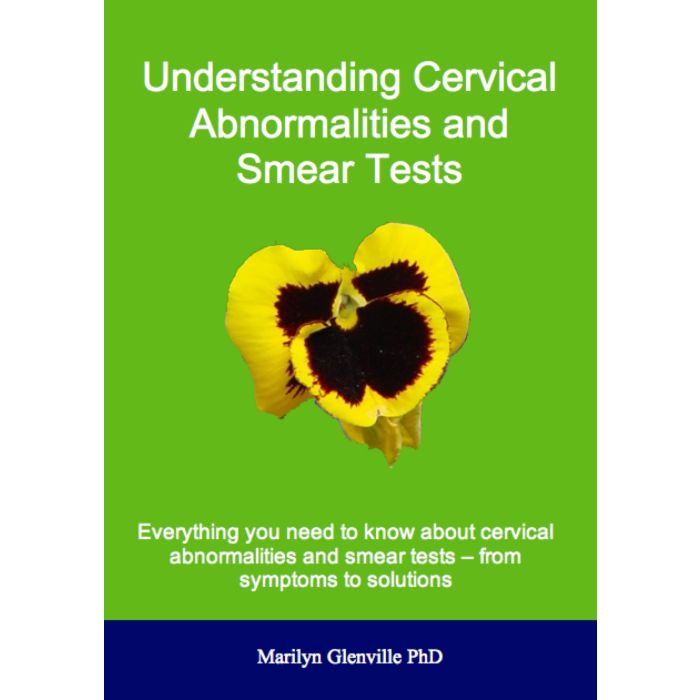Product added to cart
Understanding Cervical Abnormalities and Smear Tests E-book
£7.94
In stock
SKU
NHP.CH189
"What is a smear test?
A cervical smear test is a simple test designed to detect abnormalities in the cells of the cervix. It is also called a Pap (Papanicolaou) smear after the doctor who invented it. A small instrument called a speculum is inserted into the vagina and a spatula is put inside this in order to reach the neck of the womb (the cervix). Cells are gently scraped from the surface of the cervix, smeared onto a glass slide and then sent to a laboratory for examination...
 Understanding Breast Problems E-book Previous
Understanding Breast Problems E-book Previous 
"What is a smear test?
A cervical smear test is a simple test designed to detect abnormalities in the cells of the cervix. It is also called a Pap (Papanicolaou) smear after the doctor who invented it. A small instrument called a speculum is inserted into the vagina and a spatula is put inside this in order to reach the neck of the womb (the cervix). Cells are gently scraped from the surface of the cervix, smeared onto a glass slide and then sent to a laboratory for examination.
The cells are graded according to the degree of change that is seen under a microscope. If changes are found in cells from the cervix then a colposcopy is often suggested (see below).
If you have a hysterectomy and the cervix was removed then you do not need to have any more smears.
Reliability of the Smear Test
The major problem is that these changes are often read incorrectly. There are a number of 'false positives', where you can be given the diagnosis of cervical cancer when, in fact, the changes are benign (harmless). There are also 'false negatives', where you can be told that everything is fine when there is evidence of cancer of the cervix. If you have been told the smear is positive (even though it is not - a 'false positive'), you would at least be sent for a colposcopy (see below) and the diagnosis can be confirmed. The worse scenario is getting a false negative, because there could be a risk of undiagnosed cancer, and no further tests would be arranged.
These mistakes have led to a number of deaths from cervical cancer, which should have been picked up earlier, and also to many emergency hysterectomies. But in the case of false diagnoses of cancer, women have gone through needless emotional suffering and anxiety. Sometimes, too few cells are taken, which means that you have to repeat the smear. This can obviously be the source of great anxiety for many women..."
REMEMBER:
When you order this e-book you will receive an extra 2 e-books ("The Foundation of Health" and "Using Natural Medicine") worth over ᆪ15 absolutely free.
| Understanding Cervical Abnormalities and Smear Tests | 2 |
| Table of Contents | 3 |
| Disclaimer | 5 |
| Copyright | 5 |
| Cervical Abnormalities and Smear Tests | 6 |
| What causes Cervical Dysplasia? | 6 |
| Smear Tests and Cervical Abnormalities | 7 |
| What is a smear test? | 7 |
| Reliability of the Smear Test | 7 |
| Classification of Cell Changes (CIN) | 8 |
| The 'wait and see' approach | 8 |
| What to Do | 8 |
| Reliability of the HPV Test | 9 |
| What is HPV (Human Papillomavirus)? | 9 |
| Cervical Dysplasia - Risk Factors | 9 |
| When to see your doctor | 10 |
| Other reasons for unusual bleeding between periods | 10 |
| What treatment can you be offered by your doctor | 10 |
| Colposcopy | 10 |
| Drugs | 12 |
| Imiquimod | 12 |
| HPV Vaccine | 12 |
| The Surgical Approach | 13 |
| Diathermy | 13 |
| Laser Therapy | 13 |
| Cryosurgery | 13 |
| Cone biopsy | 13 |
| Natural Approaches to Cervical Dysplasia (Abnormal Cell Changes) | 14 |
| Dietary changes | 14 |
| Supplements | 15 |
| Vitamin A and beta-carotene | 15 |
| Vitamin E | 15 |
| Vitamin C | 15 |
| Vitamin B6 | 16 |
| Folic acid | 16 |
| Selenium | 16 |
| Zinc | 16 |
| Herbs | 18 |
| Echinacea (Echinacea purpurea) | 18 |
| Cat's Claw (Uncaria tomentosa) | 18 |
| Astralagus (Astralagus membranaceus) | 18 |
| Thuja (Thuja occidentalis) | 18 |
| Golden Seal (Hydrastis canadensis) | 18 |
| The Integrated Treatment Plan | 20 |
| Your Supplement Plan | 21 |
| Herbs | 21 |
| The Next Step | 22 |
| Other E-books in this Series | 23 |
| References | 24 |
| What's the cause? | 22 |
| Genetic factors | 22 |
| Hormone Replacement Therapy (HRT) | 22 |
| Weight | 22 |
| Fats | 23 |
| Stress | 23 |
| Cosmetics and deodorants | 24 |
| Pesticides | 24 |
| What about mammograms? | 25 |
| Screening for Breast Cancer | 26 |
| Ultrasound | 26 |
| Hair tests | 26 |
| Electrical Scanner | 26 |
| The Next Step | 28 |
| Other E-books in this Series | 29 |
| References | 30 |
Quality Assured
All the NHP supplements included in this programme have been given Dr Marilyn Glenville PhD's Exclusive ‘Seal of Approval
To be awarded Dr Glenville’s Exclusive Seal of Approval all NHP supplements have been formulated and personally checked and approved by Dr Marilyn Glenville PHD, the UK’s leading nutritionist specialising in natural health.
To comply they need to be in the correct form, the right dosage level and of the highest quality to ensure maximum bio-availability and absorption in order to increase their effectiveness and produce the greatest benefit and be free from all non-active and chemical excipients.
All formulations must conform to Dr Glenville’s demanding criteria:
- Only 100% active ingredients included
- In their most bio-available form to aid absorption,
No minerals in the form of chlorides, carbonates, oxides or sulphates.
Vitamin C in alkaline form rather than the acidic ascorbic acid form
Vitamin D as D3 not D2
Vitamin B6 in the active form of pyridoxal-5-phosphate and not the cheaper pyridoxine form
Natural vitamin E as d-alpha tocopherol not synthetic dl-alpha tocopherol - Free From: gluten, dairy, yeast, artificial flavours, colours, additives, preservatives, added sugar, sweeteners, benzoates, maltodextrin, nuts and nut traces and soya* *(except Meno Herbal Support, Advanced Brain and Memory Support and Advanced Hearing Support)
- Free From - fillers, binders, anti-caking agents, lubricants eg magnesium stearate, titanium dioxide, talc, calcium hydrogen phosphate dehydrate, stearic acid.
- Contained in vegan* capsules - no bovine gelatine used
*(excluding Omega 3 Support and Advanced Marine Collagen Support which are in vegetarian capsules) - No genetically modified organisms (GMOs)
- Registered with the Vegetarian Society*
*(excluding Omega 3 Support and Advanced Marine Collagen Support which are in vegetarian capsules) - Registered with the Vegan Society*
*(excluding Omega 3 Support and Advanced Marine Collagen Support which are in vegetarian capsules) - Kosher and Halal approved
- Omega 3 fish oil. High Strength made from wild deep-sea fish and from the body of the fish not the liver. In natural triglyceride form. Screened for contaminants. Frends Of The Sea certified
- Manufactured, batch tested and certified in the UK
- Contained in glass bottles for easy recycling
Thanks to Dr Glenville’s 30+ years’ experience and stringent quality control checking procedures, you can be confident that any product with Dr Glenville’s Exclusive ‘Seal of Approval’ is effective, safe and healthy for you to use.
Does all this really make a difference?
When you take vitamins, minerals, and herbs, you aim to give your body the tools to heal itself and maintain good health.
Unfortunately, many supplements nowadays contain unnecessary and potentially harmful substances, making your body work harder to eliminate them.
You may not realise that they can be full of ‘nasties’ - non-active ingredients - like, fillers, bulking and anti-caking agents, disintegrants and lubricants.
These chemicals are in there to help the manufacturing process flow through the machines.
Good for the machines maybe but certainly not good for your body.
If your body expends energy dealing with these substances, it may divert energy from other areas essential for maintaining or restoring good health, potentially causing additional health problems and low energy.
It's crucial that the vitamins, minerals, and herbs you consume contain only the highest quality ingredients possible and are Free From all nasties.
Not all supplements are made equal, and knowing what to look for is important.
Sounds daunting doesn’t it?
But don’t worry because, if you don’t have the time or inclination, (or a degree in chemistry), to go round reading labels on every pot of vitamins or minerals, Dr Glenville has already done the work and scrutinised the labels for you.
And only when she is completely satisfied that the products are Free From all the ‘nasties’ and in their most bio-available form and at the highest safe dosage level will she award it her ‘Seal of Approval’.’.
You can rest assured that all NHP supplements have Dr Glenville’s exclusive ‘Seal of Approval’ and are safe, effective and healthy for you.
If you would like more help and guidance please email one of our nutritionists, who will be pleased to recommend an appropriate course of action for you, by clicking the button below:





